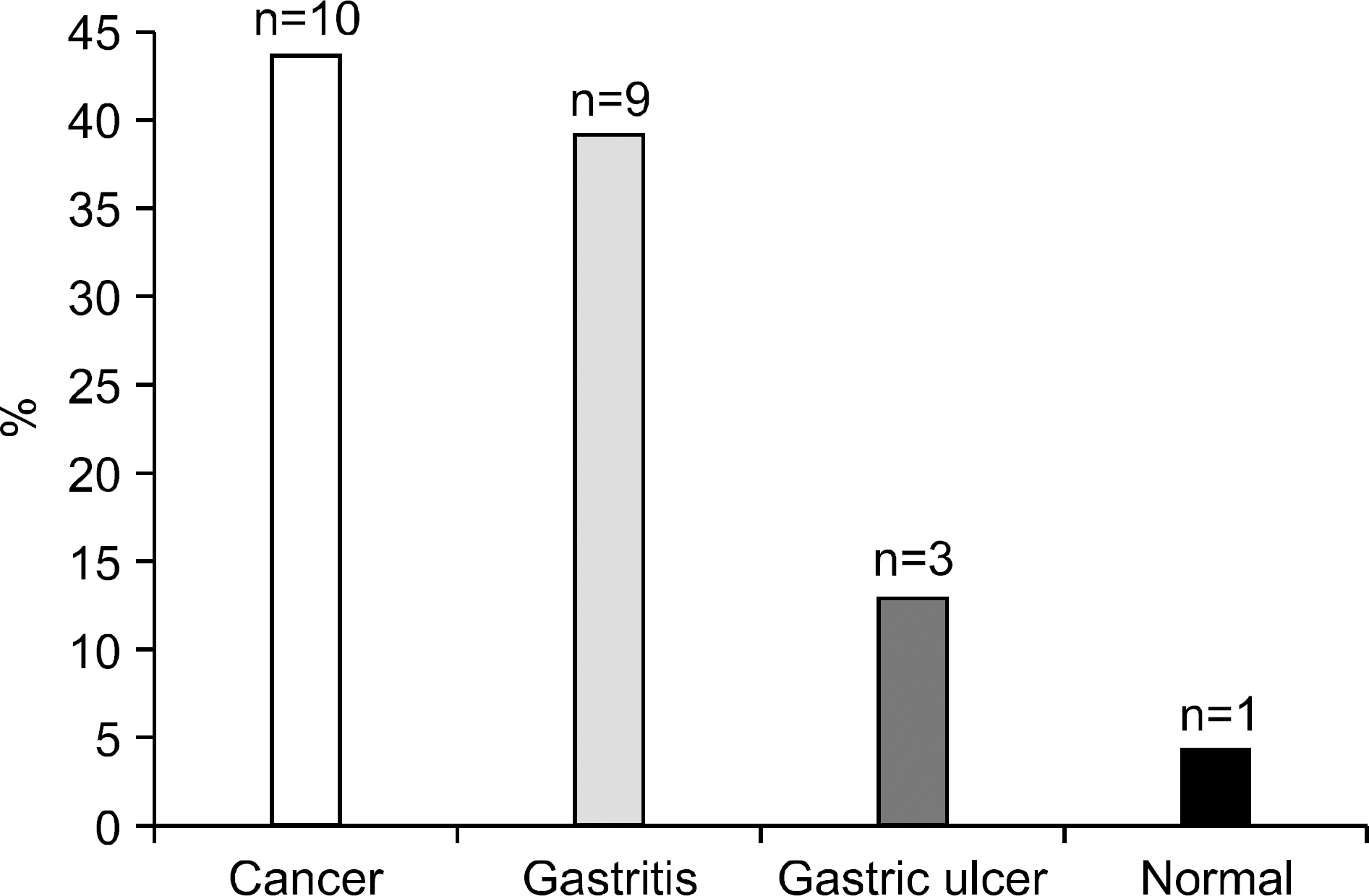Korean J Gastroenterol.
2009 Sep;54(3):149-154. 10.4166/kjg.2009.54.3.149.
Clinical Significance of Bowel Wall Thickening Detected with 64-Slice Multidetector Computed Tomography
- Affiliations
-
- 1Department of Internal Medicine, Chungbuk National University College of Medicine, Cheongju, Korea. sjyoun@chungbuk.ac.kr
- 2Department of Radiology, Chungbuk National University College of Medicine, Cheongju, Korea.
- KMID: 1775950
- DOI: http://doi.org/10.4166/kjg.2009.54.3.149
Abstract
- BACKGROUND/AIMS
The multidetector computed tomography (MDCT) scanning frequently leads to the incidental discovery of bowel wall thickening. The aim of this study was to determine the utility of gastroscopy and colonoscopy in the management of patients who had incidental discovery of bowel wall thickening on MDCT. METHODS: From May 2006 to March 2008, the abdominal MDCT reports of all patients in Chungbuk National University Hospital were reviewed. Cases with any bowel thickening was selected and then patients who received gastroscopy or colonoscopy after abdominal MDCT were re-selected. RESULTS: Gastroscopy revealed abnormal findings in 22 (95.7%) out of 23 patients, and 10 patients (43.5%) had stomach cancers. Colonoscopy revealed abnormal findings in 35 (85.4%) out of 41 patients, and 12 patients (29%) had malignant tumors. In the patients who had lymph node enlargement (p<0.001), dirty fat infiltration (p=0.025), and irregular wall thickening (p<0.001) on MDCT malignancy was observed more frequently. CONCLUSIONS: We recommend gastroscopy and colonoscopy to patients who had incidentally found bowel wall thickening on MDCT, especially those with lymph node enlargement, dirty fat infiltration, and irregular wall thickening.
MeSH Terms
Figure
Reference
-
1. Jaffe TA, Nelson RC, Johnson GA, et al. Optimization of multiplanar reformations from isotropic data sets acquired with 16-detector row helical CT scanner. Radiology. 2006; 238:292–299.
Article2. Prokop M. General principles of MDCT. Eur J Radiol. 2003; 45(suppl 1):S4–S10.
Article3. Sebastian S, Kalra MK, Mittal P, et al. Can independent coronal multiplanar reformatted images obtained using state-of-the-art MDCT scanners be used for primary interpretation of MDCT of the abdomen and pelvis? A feasibility study. Eur J Radiol. 2007; 64:439–446.
Article4. Marinck B. Nontraumatic abdominal emergencies: acute abdominal pain: diagnostic strategies. Eur Radiol. 2002; 12:2136–2150.
Article5. Coscina WF, Arger PH, Levine MS, et al. Gastrointestinal tract forcal mass lesions: role of CT and barium evaluations. Radiology. 1986; 159:581–587.6. Insko EK, Levine MS, Birnbaum BA, Jacobs JE. Benign and malignant lesions of the stomach: evaluation of CT criteria for differentiation. Radiology. 2003; 228:166–171.
Article7. Rockey DC, Halvorsen RA Jr, Higgins JL, et al. Prospective evaluation of patients with bowel wall thickening. Am J Gastroenterol. 1995; 90:99–103.8. Hopper KD, Huber SJ, Kasales CJ, et al. The clinical usefulness of routine stacked multiplanar reconstruction in helical abdominal computed tomography. Invest Radiol. 1997; 32:550–556.
Article9. Raouf EH, Linda R, Garmo PD. The clinical significance of bowel wall thickening on abdominal CT scan. Am J Gastroenterol. 2001; 96:268–269.10. Caig Q, Baumgarten DA, Affronti JP, Waring JP. Incidental findings of thickening luminal gastrointestinal organs on computed tomography: an absolute indication for endoscopy. Am J Gastroenterol. 2003; 98:1734–1737.11. Wolff JH, Rubin A, Potter JD, et al. Clinical significance of colonoscopic findings associated with colonic thickening on computed tomography: is colonoscopy warranted when thickening is detected? J Clin Gastroenterol. 2008; 42:472–475.
- Full Text Links
- Actions
-
Cited
- CITED
-
- Close
- Share
- Similar articles
-
- Clinical Significance of Incidentally Detected Bowel Wall Thickening on Abdominal Computerized Tomography Scan
- Bowel Wall Thickening on Computed Tomography in Children: A Novel Method of Measurement and Its Clinical Significance
- The Influence of Heart Rate and its Variations on Image Quality: A Comparative Study of 16- and 64-Slice Multidetector Row Computed Tomography
- Clinical Usefulness of 64-Channel Multidetector Computed Tomography, Capsule Endoscopy, and Double-Balloon Enteroscopy in Obscure Gastrointestinal Bleedings
- Ileal Heterotopic Gastric Mucosa with Small Bowel Obstruction Mimicking Inflammatory Bowel Disease: A Case Study



